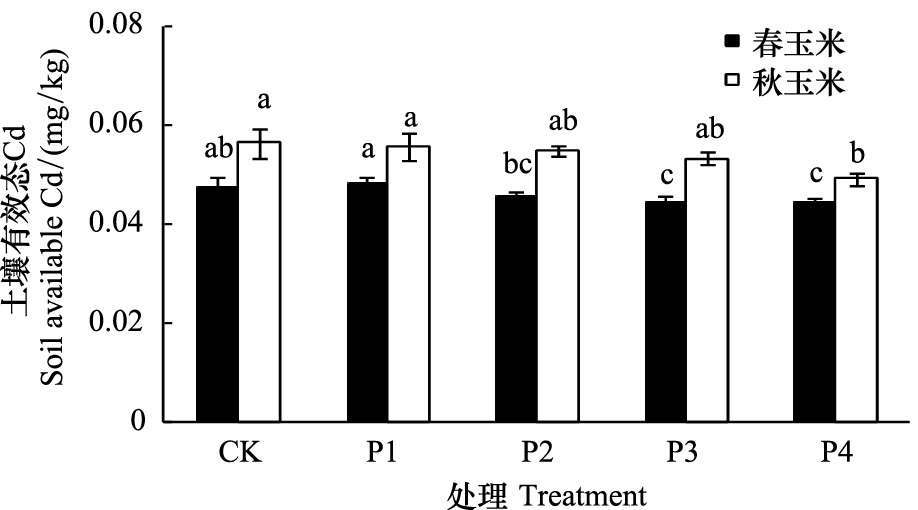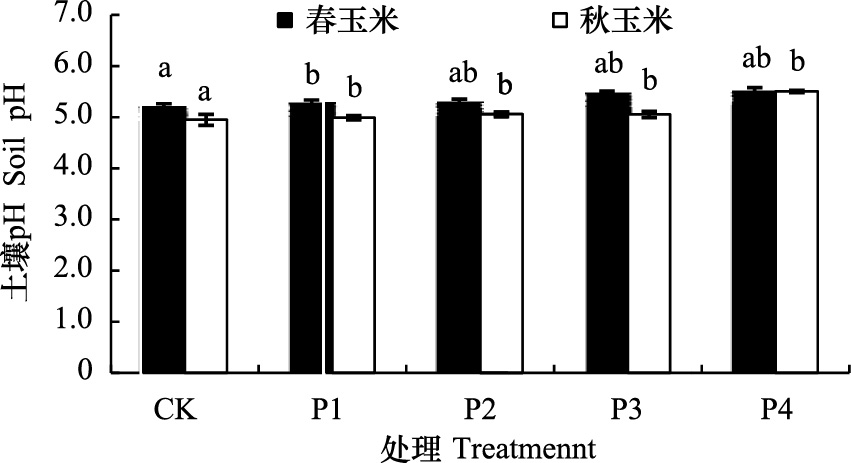文章信息
- 区惠平, 刘昔辉, 黄金生, 周柳强, 曾艳, 韦运兰, 谢如林, 谭宏伟
- OU Huiping, LIU Xihui, HUANG Jinsheng, ZHOU Liuqiang, ZENG Yan, WEI Yunlan, XIE Rulin, TAN Hongwei
- 广西典型红壤旱地施用钙镁磷肥对玉米产量及其镉累积的影响
- Effect of calcium-magnesia phosphate fertilizer on maize yield and its cadmium accumulation in upland red soil in Guangxi
- 生态学报, 2014, 34(18): 5300-5305
- Acta Ecologica Sinica, 2014, 34(18): 5300-5305
- http://dx.doi.org/10.5846/stxb201405100949
-
文章历史
- 收稿日期:2014-5-9
- 修订日期:2014-8-11
2. 广西农科院甘蔗研究所, 南宁 530007
2. Sugarcane Research Institute, Guangxi Academy of Agricultural Sciences, Nanning 530007, China
镉(Cd)是一种重金属元素,位列联合国环境规划署提出的12种具有全球性意义的危险化学物质之首。土壤Cd通过植物吸收经食物链进入人体,是危害人类健康的主要途径。因此,查明土壤中Cd污染源,并从源头上加以控制,对改善土壤环境质量,确保农产品安全具有重要意义。
由于磷矿中伴生大量的Cd,其60%—80%的Cd会在磷肥的生产过程中转移到肥料中去[1],磷肥施用成了Cd在土壤中累积的主要原因,占人类活动对土壤Cd总贡献的54%—58%[2]。人们对磷肥施用的关注已超出原来单纯的农学效应,其潜在Cd的环境风险更加备受关注。国外研究表明,长期施用含Cd磷肥显著增加土壤Cd全量[3, 4, 5]及有效含量[5],两者间呈显著的剂量效应[6];施用高Cd磷肥或增施含Cd磷肥均可促进作物Cd累积量增加[7, 8]。说明磷肥中的Cd可对土壤环境以及农产品的Cd安全产生显著影响。
近年来,我国学者在污染农田上开展了磷肥施用对作物Cd累积的影响研究,但主要侧重于磷肥的修复效应[9, 10, 11],而忽视磷肥中的Cd对作物Cd累积的影响。针对赤红壤上由于低Cd磷肥不同施用量诱发的玉米Cd累积及生物有效性更是未见报道。本实验采用田间试验,研究低Cd钙镁磷肥不同施用量下土壤Cd的有效性及玉米地上部秸秆和籽粒对土壤Cd的吸收、累积特征,以期为磷肥的合理施用以及玉米生产中控制和减少玉米对土壤Cd的吸收提供理论依据。
1 材料与方法采用大田试验,于2011年在广西武鸣里建英才村进行。该区属南亚热带湿润季风气候区,年平均气温21.7℃,年均降水量1300 mm。供试春、秋玉米(Zea mays)品种均为迪卡008。供试土壤为砂页岩发育的铁质湿润雏形土,有机质27.8 g/kg,全氮1.10g/kg,碱解氮134 mg/kg,速效磷 14 mg/kg,速效钾112 mg/kg,全Cd 0.1504 mg/kg,pH(H2O)5.40。供试磷肥为钙镁磷肥,其中P2O5含量为180 g/kg,Cd含量为0.0651 mg/kg。
1.2 试验设计磷肥施用量以P2O5计,以农民习惯磷肥施用量为基础,采用翻倍施用量效仿多年连续累积施用量。共设4个施P2O5水平,分别用P1、P2、P3和P4表示,其中P1处理为单造当地农民习惯磷肥施用量,P2、P3和P4处理分别为1a、2a和4a累计施用量,以不施磷肥作为对照(CK处理)。氮、磷、钾肥具体施用量和伴随钙镁磷肥施用进入农田的Cd含量见表 1。每处理3次重复,随机区组排列。小区面积2 5.2 m2,小区间以田间小沟隔开。氮、磷、钾肥分别按基肥:追肥为1 ∶ 1、1 ∶ 0、1 ∶ 1的比例施用。基肥采用沟施的方法,施肥后盖土。追肥采用穴施的方法施于两株玉米之间,施肥后盖土。基肥和追肥春玉米分别于2月28日和6月21日施入,秋玉米于7月30日和9月14日施用。春、秋玉米分别于2月23日和7月30日播种,采用单行种植,行距为60 cm,株距为30 cm,种植密度55545株/hm2,于7月20日和11月25日收获。
| 处理(施肥水平)Treatments | 春玉米Spring corn | 秋玉米Autumn corn | ||||||
| P2O5/ (kg/hm2) | Cd/ (mg/hm2) | N/ (kg/hm2) | K2O/ (kg/hm2) | P2O5/ (kg/hm2) | Cd/ (mg/hm2) | N/ (kg/hm2) | K2O/ (kg/hm2) | |
| CK | 0 | 0 | 240 | 225 | 0 | 0 | 240 | 225 |
| P1 | 75 | 27.13 | 75 | 27.13 | ||||
| P2 | 150 | 54.25 | 150 | 54.25 | ||||
| P3 | 300 | 108.50 | 300 | 108.50 | ||||
| P4 | 600 | 217.00 | 600 | 217.00 | ||||
玉米收获时,全小区分秸秆及籽粒测产。同时,每小区取生长均匀的6兜平地收获地上部和采集耕层土壤样品。地上部分秸秆和籽粒两个部位,其中秸秆切短为2—3 cm混合均匀,于105℃杀青30 min,60℃烘干粉碎,过60目筛备用,籽粒60℃烘干粉碎,过60目筛。用HNO3-HClO4(2 ∶ 1)湿法消化[12],石墨炉原子吸收法[13]测定Cd含量。土壤自然风干,粉碎,过18目,采用NH4OAc提取[14],石墨炉原子吸收法[13]测定土壤有效Cd含量,1 ∶ 2.5的土水比浸提,电位法[12]测定土壤pH。
1.4 数据处理数据处理、作图、方差分析等采用Excel 2007和DPS 7.05等软件完成,采用LSD法进行多重比较。
2 结果与分析 2.1 施磷量对玉米产量的影响由表 2可以看出,施磷显著增加玉米籽粒产量。与CK相比,春、秋玉米籽粒产量施磷处理分别提高8.2%—13.1%和13.6%—20.0%,差异达到显著水平(P<0.05);然而,不同施磷量间玉米籽粒产量差异不显著。春玉米秸秆产量以P4处理最高,显著高于对照11.4%。春、秋玉米秸秆产量P1—P3处理均与对照相当。
| 处理 Treatment | 籽粒产量 Grain yield/ (kg/hm2) | 秸秆产量 Biomass/ (kg/hm2) | |
| 不同小写字母分别代表处理间差异达到显著水平(P<0.05) | |||
| 春玉米 | CK | 4449.6±139.4 b | 6262.5±278.0 b |
| Spring corn | P1 | 4813.6±201.0 a | 6640.7±83.8 ab |
| P2 | 4985.1±138.6 a | 6794.8±206.1 ab | |
| P3 | 5033.5±145.4 a | 6814.9±175.0 ab | |
| P4 | 4951.5±219.9 a | 6975.6±66.6 a | |
| 秋玉米 | CK | 3013.5±64.4 b | 4953.1±45.6 a |
| Autumn corn | P1 | 3425.0±44.1 a | 5237.3±200.7 a |
| P2 | 3555.5±30.8 a | 5269.1±116.7 a | |
| P3 | 3617.6±97.9 a | 5349.6±94.9 a | |
| P4 | 3502.7±66.8 a | 5306.1±92.8 a | |
由表 3可看出,茎叶和籽粒Cd含量均低于国家粮食卫生控制标准0.2 mg/kg1的规定(GB2762—2005)。施磷降低玉米秸秆和籽粒对Cd的吸收,且玉米秸秆和籽粒Cd含量随施磷量的增加而减少。增施75—600 kg P2O5/hm2,春、秋玉米秸秆Cd含量降幅分别达2.7%—45.8%和11.0%—43.6%,籽粒Cd含量降幅达13.0%—40.6%和9.9%—31.5%。其中,P3和P4处理显著低于对照和P1处理。
| 处理 Treatment | 秸秆Cd含量 Cd concentration in straw/ (mg/kg) | 籽粒Cd含量 Cd concentration in grain/ (mg/kg) | |
| 春玉米 | CK | 0.084±0.001 a | 0.014±0.001 a |
| Spring corn | P1 | 0.082±0.000a | 0.013±0.000 ab |
| P2 | 0.075±0.001b | 0.011±0.000 bc | |
| P3 | 0.071±0.000 c | 0.009±0.001 cd | |
| P4 | 0.045±0.001 d | 0.009±0.001 d | |
| 秋玉米 | CK | 0.100±0.002 a | 0.052±0.001 a |
| Autumn corn | P1 | 0.089±0.002 b | 0.047±0.002 ab |
| P2 | 0.074±0.002 c | 0.045±0.002 ab | |
| P3 | 0.065±0.007 cd | 0.043±0.003 bc | |
| P4 | 0.057±0.002 d | 0.036±0.003 c |
由表 4可以看出,与对照相比,施入75 kg P2O5/hm2对玉米秸秆及籽粒Cd累积量无显著影响;当施磷量大于300 kg P2O5/hm2时,玉米秸秆和籽粒Cd累积量显著下降。随施磷量的增加,玉米秸秆及籽粒Cd累积量逐渐下降,以P4处理最低,分别低于P1、P2和P3处理13.6%—41.5%和8.8%—29.3%。
| 处理Treatment | Cd累积量 Cd accumulation amount/(mg/hm2) | |||
| 籽粒Grain | 秸秆Residue | 合计Total | ||
| 春玉米 | CK | 65.4±9.8 a | 526.5±41.8 a | 591.9±50.9 a |
| Spring corn | P1 | 61.4±4.4 a | 543.4±10.7 a | 604.7±6.5 a |
| P2 | 57.5±5.2 ab | 508.5±21.1 ab | 566.0±19.5 ab | |
| P3 | 47.6±5.9 bc | 484.6±15.6 b | 532.2±20.7 b | |
| P4 | 43.4±10.1 c | 318.0±12.4 c | 361.4±22.5 c | |
| 秋玉米 | CK | 157.8±4.2 a | 497.1±25.3 a | 654.9±29.1 a |
| Autumn corn | P1 | 161.6±10.6 a | 466.9±15.7 a | 628.5±11.4 a |
| P2 | 161.1±15.7 a | 387.5±4.5 b | 548.6±13.9 b | |
| P3 | 153.8±11.9 a | 347.5±60.9 bc | 501.4±72.6 b | |
| P4 | 125.3±15.4 b | 300.3±24.9 c | 425.6±39.8 c | |
由图 1可以看出,与CK处理相比,磷肥施用不同程度地降低土壤有效Cd含量,其中,春玉米中P2、P3和P4处理土壤有效Cd含量分别降低4.6%、7.1%和7.3%;秋玉米分别降低2.7%、5.6%和12.8%。

|
| 图 1 不同施磷施用量下土壤有效Cd含量变化 Fig. 1 Changes of soil available Cd content under different phosphate fertilization rate CK,P1—P4为施肥水平 |
土壤Cd的有效性随磷肥施用量的不同呈现不同程度的差异。施用量75—600 kg P205/hm2范围内,随着施磷量的增加,土壤有效Cd含量下降。春玉米栽培季节,P1处理中土壤有效Cd含量比P2、P3、P4处理分别提高5.7%、8.7%和8.8%,差异显著;但P2、P3、P4处理间差异不显著;秋玉米栽培季节,土壤有效Cd含量除了P1与P4处理间差异显著外,其他处理间差异不显著。
2.5 不同施磷量对土壤pH的影响从图 2可以看出,施用磷肥提高玉米地土壤pH,且土壤pH随施磷量的增加而升高。当施磷量为600kg/hm2时,春玉米土壤pH分别比CK、P1、P2和P3处理分别提高0.31、0.24、0.22和0.05个pH单位,秋玉米分别提高0.55、0.51、0.45和0.45个pH单位,间差异显著。

|
| 图 2 不同磷肥施用量下土壤pH的变化 Fig. 2 Changes of soil pH under different phosphate fertilization rate |
将玉米Cd含量与土壤pH和有效Cd含量作相关性分析(表 5)发现,玉米秸秆、籽粒Cd含量与土壤有效Cd呈显著正相关,与pH值呈显著负相关。而磷肥施用量与土壤有效Cd含量呈显著负相关,与pH值呈显著正相关。表明磷肥通过提高土壤pH和降低土壤有效Cd含量影响玉米对Cd的吸收累积。
| 项目Item | 土壤pH Soil pH | 有效态Cd Soil available Cd | |
| *和**分别代表P<0.05和P<0.01(n=5,r0.05=0.751,r0.01=0.874) | |||
| 春玉米Spring corn | 秸秆Cd含量Cd content in straw | -0.8757* * | 0.7744* |
| 籽粒Cd含量 Cd content in grains | -0.9745* * | 0.9148* * | |
| 磷肥施用量 Phosphate application rate | 0.9464* * | -0.8302* | |
| 秋玉米Autumn corn | 秸秆Cd含量Cd content in straw | -0.7768* | 0.8832* * |
| 籽粒Cd含量 Cd content in grains | -0.9008* * | 0.9644* * | |
| 磷肥施用量 Phosphate application rate | 0.9469* * | -0.9972* * | |
研究指出,Cd是生物迁移性极强的重金属,极易被植物吸收并在体内积累,超过一定限度可能会产生毒害而影响正常产量[15]。本研究中,施磷显著增加玉米籽粒产量。说明磷肥中虽然含有一定的Cd含量,但这对玉米并无减产作用。试验在田间观察中也并没有发现玉米Cd毒害的症状。这可能与随磷肥进入土壤的Cd含量较低有关。众多研究表明,低浓度Cd对植物生长有积极的“刺激作用”,而较高的Cd含量才会对作物产生毒害作用[16, 17]。由玉米籽粒产量在不同的施磷处理间差异不显著,推断P1水平(75 kg P2O5/hm2)是玉米适宜的施磷量。
玉米籽粒Cd含量的多少直接关系人类的健康。本试验所有处理中玉米籽粒Cd含量均低于国家粮食卫生控制标准,说明施低Cd钙镁磷肥施用不会造成玉米Cd超标。相反,与CK相比,增施75—600 kg P2O5/hm2,玉米对Cd的吸收累积量随施磷量的增加而降低。其中,秸秆中Cd含量降幅达2.7—45.8%(春玉米)和11.0—43.6%(秋玉米);籽粒Cd含量降幅达13.0—40.4%(春玉米)和9.9—31.5%(秋玉米)。以上结果表明:施用磷肥既能提高作物产量,又能降低作物Cd污染。这一结果与国内外许多研究结论是相类似。Dheri等[18]的盆栽试验中,磷肥的施用不仅使得供试菠菜的生物量增加34%(壤土)和45%(沙土),而且减少了菠菜中Cd的含量。在50 mg P2O5/kg土的磷肥施用量下,磷肥增加小麦干物质重,同时减缓作物Cd、Pb毒害[19]。Wang等[20]发现,磷矿粉、钙镁磷肥和过磷酸钙均可显著减少污染土壤中小白菜对Cd的吸收累积量。因而,钙镁磷肥施用可作为一个经济、有效地降低作物Cd吸收量的措施。
研究表明,pH对Cd的生物有效性有重要影响。一方面,pH值影响土壤对Cd的吸附容量,pH值在4.0—7.7之间每上升1个pH值单位,土壤对Cd的吸附容量增加3倍,大大降低Cd向植物的迁移能力[21]。另一方面,在碱性条件下,会生产CdCO3、Cd(OH)2沉淀。磷肥诱导土壤pH和表面电荷的提高从而提高土壤Cd的固定[22];同时,磷肥本身与Cd形成磷酸Cd沉淀和含钙磷肥施用引起的植物钙与Cd的竞争吸收也可降低土壤Cd的生物有效性[9, 23]。本试验中,与CK相比,磷肥施用后土壤pH值上升,有效Cd含量下降(图 1,图 2),玉米秸秆、籽粒Cd含量与有效Cd含量显著正相关,与pH值显著负相关(表 5)。说明磷肥降低玉米吸收累积Cd是通过pH值的上升,有效Cd含量的下降实现的。
| [1] | Torbert H A, Daniel T C, Lemunyon J L, Jones R M. Relationship of soil test phosphorus and sampling depth to runoff phosphorus in calcareous and noncalcareous soils. Journal of Environmental Quality, 2002, 31(4): 1380-1387. |
| [2] | He Z L. Pollution and Soil Chemical Balance of the Beneficial Elements. Beijing: China Environment Science Press, 1998:129-130. |
| [3] | McGrath D, Tunney H. Accumulation of cadmium, fluorine, magnesium, and zinc in soil after application of phosphate fertilizer for 31 years in a grazing trial. Journal of Plant Nutrition and Soil Science, 2010, 173(4): 548-553. |
| [4] | Rochayati S, Verloo M,DuLaing G. Availability of cadmium and zinc as affected by the use of reactive phosphate rock, lime, and chicken manure on an Indonesian acidic upland soil under field conditions. Communications in Soil Science and Plant Analysis, 2010, 41(16): 1986-2003. |
| [5] | Lambert R, Grant C, Sauvé S. Cadmium and zinc in soil solution extracts following the application of phosphate fertilizers. Science of the Total Environment, 2007, 378(3): 293-305. |
| [6] | Jafarnejadi A R, Sayyad G, Homaee M, Davamei A H. Spatial variability of soil total and DTPA-extractable cadmium caused by long-term application of phosphate fertilizers, crop rotation, and soil characteristics. Environmental Monitoring and Assessment, 2013, 185(5): 4087-4096. |
| [7] | GonalvesV C, MeurerE J, TatschF R P, CarvalhoS A, dos Santos NetoOA. Cadmium bioavailability in phosphate fertilizers. RevistaBrasileira de Ciência do Solo, 2008, 32: 2871-2875. |
| [8] | Pérez A L, Anderson K A. DGT estimates cadmium accumulation in wheat and potato from phosphate fertilizer applications. The Science of the Total Environment, 2009, 407(18): 5096-5103. |
| [9] | LiuZ B, JiX H, Peng H, Tian F X, Wu J M, Shi L H. Effects of phosphorous fertilizers on phytoavailability of cadmium in its contaminated soil and related mechanisms. Chinese Journal of Applied Ecology, 2012, 23(6): 1585-1590. |
| [10] | Dong S H, Li J, Zhao M. Influence of phosphate application on rice absorbing and accumulation of Cd in Cd polluted paddy soil. Journal of Northeast Agricultural University, 2010, 41(9): 39-43. |
| [11] | Jiaka L T, Yu H, Feng W Q, Qin Y S, Zhao J, Liao M L, Wang C Q, Tu S H. Effects of different phosphate and potassium fertilizers on yields and cadmium uptake by paddy rice. Southwest China Journal of Agricultural Science, 2009, 22(4): 990-995. |
| [12] | Lu R K. Routine Analysis Methods of Soil Agricultural Chemical. Beijing: China Agriculture Press, 2000. |
| [13] | Wang T S, Fang F X, Yang Y X, Liang J, Mo L X, Fan Y G, Tang Z L. Determination of cadmium and lead in sugarcane by graphite furnace atomic absorption spectrometer with zeeman correction. Agricultural Science and Technology, 2011, 12(5): 630-631, 638-638. |
| [14] | Andrews P, Town R M, Hedley M J, Loganathan P. Measurement of plant-available cadmium in New Zealand soils. Australian Journal of Soil Research, 1996, 34(3): 441-452. |
| [15] | Xiong L M, Lu R K. Cadmium distribution in rice and its influencing factors. Soils, 1992, (3): 138-141, 145-145. |
| [16] | He J Y, Wang Y Y, Ren Y F, Zhou G Q, Yang L J. Effect of cadmium on root morphology and physiological characteristics of rice seedlings. Ecology and Environmental Sciences, 2009, 18(5): 1863-1868. |
| [17] | Patra J, Lenka M, Panda B B. Tolerance and co-tolerance of the grass Chlorisbarbata Sw. to mercury, cadmium and zinc. New Phytologist, 1994, 128(1): 165-171. |
| [18] | Dheri G S, Brar M S, Malhi S S. Influence of phosphorus application on growth and cadmium uptake of spinach in two cadmium-contaminated soils. Journal of Plant Nutrition and Soil Science, 2007, 170(4): 495-499. |
| [19] | Chen S, Sun T H, Sun L N, Zhou Q X, Chao L. Influences of phosphate nutritional level on the phytoavailability and speciation distribution of cadmium and lead in soil. Journal of Environmental Sciences, 2006, 18(6): 1247-1253. |
| [20] | Wang B L, Xie Z M, Chen JJ, Jiang J T, Su Q F. Effects of field application of phosphate fertilizers on the availability and uptake of lead, zinc and cadmium by cabbage(Brassicachinensis L.) in a mining tailing contaminated soil. Journal of Environmental Sciences, 2008, 20(9): 1109-1117. |
| [21] | Yang X E, Yang M J. Transfer of cadmium from agricultural soils to human food chain. Trace Elements Science, 1996, 3(7): 1-13. |
| [22] | Bolan N S, Adriano D C, Duraisamy P, Mani A, Arulmozhiselvan K. Immobilization and phytoavailability of cadmium invariable charge soils: I. Effect of phosphate addition. Plant and Soil, 2003, 250(1): 83-94. |
| [23] | Matusik J, Bajda T, Manecki M. Immobilization of aqueous cadmium by addition of phosphates. Journal of Hazardous Materials, 2008, 152(3): 1332-1339. |
| [2] | 何振立. 污染及有益元素的土壤化学平衡. 北京: 中国环境科学出版社, 1998:129-130. |
| [9] | 刘昭兵, 纪雄辉, 彭华, 田发祥, 吴家梅, 石丽红. 磷肥对土壤中镉的植物有效性影响及其机理. 应用生态学报, 2012, 23(6): 1585-1590. |
| [10] | 董善辉, 李军, 赵梅. 磷对镉污染土壤中水稻吸收积累镉的影响. 东北农业大学学报2010, 41(9): 39-43. |
| [11] | 甲卡拉铁, 喻华, 冯文强, 秦鱼生, 赵晶, 廖鸣兰, 王昌全, 涂仕华. 不同磷、钾肥对水稻产量和吸收镉的影响研究. 西南农业学报, 2009, 22(4): 990-995. |
| [12] | 鲁如坤. 土壤农业化学常规分析方法. 北京: 中国农业出版社, 2000. |
| [15] | 熊礼明, 鲁如坤. 镉在水稻体内的分布及其影响因素.土壤, 1992, (3): 138-141, 145-145. |
| [16] | 何俊瑜, 王阳阳, 任艳芳, 周国强, 杨良静. 镉胁迫对不同水稻品种幼苗根系形态和生理特性的影响. 生态环境学报, 2009, 18(5): 1863-1868. |
| [21] | 杨肖娥, 杨明杰. 镉从农业土壤向人类食物链的迁移. 广东微量元素科学, 1996, 3(7): 1-13. |
 2014, Vol. 34
2014, Vol. 34




